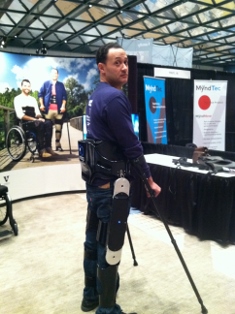|
Device That Allows the Paralyzed to Walk Is Demonstrated in Orlando  A high-tech exo-skeleton that could help millions of mobility impaired patients was demonstrated at the American Congress of Rehabilitative Medicine in Orlando this week. Its abilities go beyond allowing paralyzed patients to walk. [After spending eight years wheelchair bound, parapelegic Michael Gore walks using Indego] Indego is a lightweight, low-profile exo-skeleton that’s still in the prototype stage of its development- but it already has a pretty big “wow” factor. With Indego, parapelegic Michael Gore can walk. “It’s second nature, it’s natural, it’s almost as if I didn’t have anything on,” he says. Gore is a patient at the Shephard Center in Atlanta, which specializes in spinal chord injuries. It’s collaborating with Vanderbilt University and Parker Hannifin, (a company specializing in motion and control technologies), to develop Indego, so Gore has been using it in therapy sessions. For a patient like Gore, who has no movement in his legs, it can do all the work. Or it can provide partial assistance to someone that has difficulty walking, such as a multiple sclerosis patient. It senses how much assistance is needed and then instantly provides that. It can also send low-level electrical impulses to stimulate nerves. Shephard Lower Extremity Robotics project manager Clare Hartigan says using Indego has been phenomenal. “The reason the therapists at Shephard got so excited about this device is because you can use it with so many different people and it’s very easy to get on and off, so you can get them up, get them walking, get them the walking time that they need,” she says. Hartigan says walking is important as it supports a number of bodily functions and lowers the risk of complications and infections. Indego also records data that shows whether a stroke or MS patient is gaining strength. Hartigan says that’s the kind of information insurance companies look for. If Indego can prove its own therapeutic value, there’s a good chance it will make it to rehabilitation clinics throughout the world. |
|
|